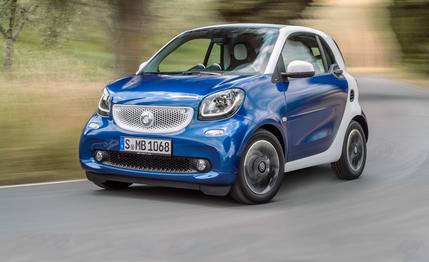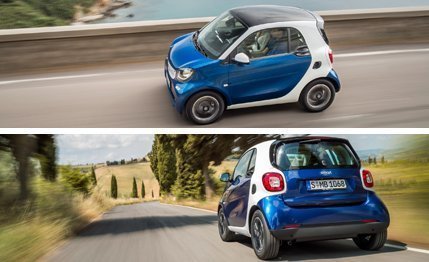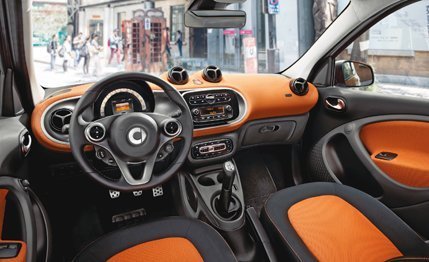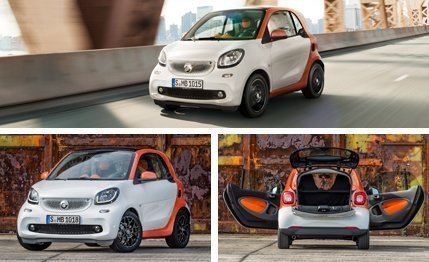 First Drive Review
First Drive Review
What’s been stopping you from buying the Smart Fortwo, America? The lurch-prone gearbox? The woeful steering? That its seats are so closely spaced that you can smell what your passenger had for lunch? (And, quite possibly, for breakfast?)
If so, we bring good news: Daimler has diligently addressed each and every one of these problems when engineering the third-generation Fortwo coming here in late 2015 as a 2016 model. Meaning that you’re all out of excuses and should head down to your local Smart dealership and join what’s certain to be a growing line outside.
Or maybe not. Because although Smart understandably highlights what makes the Fortwo better, we can’t really report any substantive changes to the fundamental proposition. Which, we’d respectfully suggest, might have been keeping more Americans from Smart ownership than any of the widely acknowledged niggles of the previous version.

Give Daimler credit for keeping the faith. The new Fortwo is as innovative as before, keeping its tiny three-cylinder engine under the trunk floor, from where it drives the rear wheels. The new Fortwo is wider than its tight-fitting predecessor but no longer, so its 106-inch overall length retains the ability to park in less than half the span of a standard parking spot. Engineering and production costs have been trimmed by sharing the new platform with Renault—whose new European Twingo is a sister car—and also by spinning off a bigger four-seat Forfour that Smart currently has no plan to bring to the U.S.
Smart let us try the Fortwo in Barcelona, so we can report that it’s certainly suited to life in a congested European city. As for life outside of a congested European city, we’ll have to extrapolate—the entire event was conducted within the downtown area, and if we hadn’t sneaked off-route for a blast down a small stretch of urban freeway, we wouldn’t have gotten the thing out of third gear. We can’t think of any “drive” event at which we’ve spent more time sitting at red lights; at least Barcelona offers spectacular buildings and beautiful people to stare at.
We also had ample time to examine the Smart’s cabin, which is definitely improved. The new car’s electronic architecture comes mostly from the Renault side of the technical alliance, with the central touch-screen display and most of the switchgear lifted straight from the Clio. Material quality isn’t on a par with what you might expect from something in the Mercedes family; your fingers don’t need to travel far to find some greasy-feeling plastics. But it’s far better assembled than the last Smart, and the extra width translates directly into improved shoulder space. Two adults can sit next to each other without mingling their DNA.

The driving experience is both familiar and better. The new Smart is a clear improvement over its predecessor by most driving measures, no more so than with the replacement of the old car’s woefully laggy automated manual gearbox. (For those who’ve never driven an original Smart, just know that you could speak entire phrases in the delay between ratios. Frequently these would be obscene phrases about the transmission.) Now Smart offers a choice of either a five-speed manual or a six-speed dual-clutch automatic. Daimler reckons the U.S. take will be about 80 percent DCT—a perfect inversion of the anticipated manual-to-auto split in Europe.
Both transmissions work well. The five-speed has a nice, light action, certainly once you’re acclimated to the clutch’s relatively sudden biting point. The pedals are well spaced for some heel-and-toe rev-matching, as well, although the turbo engine’s nonlinear response makes that harder than it should be. We were only allowed to drive a prototype version of the DCT—apparently it’s not yet as far advanced as the rest of the car—but it shifts cleanly when left to its own devices and quickly if you issue instructions by sliding the gear selector into its “manual” position. The lack of standard steering-wheel paddles is a tacit acknowledgement that this is a dual-clutch-as-automatic, though, rather than a proxy manual.

The steering is also much improved. The old Smart’s combination of a slow rack and alarming understeer meant that, at any sort of speed, it felt like trying to control a runaway mine cart. The new electrically assisted rack is quicker; the front end responds keenly and with enough grip to deal with Barcelona’s roundabouts at decent speeds. There’s no sense that the car has its engine at the back, or sends power through its rear wheels; don’t expect a miniaturized Toyota MR2. When you do reach its limits, the front nudges wide. The Fortwo also has a neat party trick in its 22.8-foot turning circle. That’s two feet better than a London cab or, more to the point in America, three feet tighter than you can accomplish in a Scion iQ.
Praise falters when we get to the new engine. The U.S. will only be taking the more powerful 89-hp turbocharged version of the transverse three-cylinder engine, and this felt excessively laggy and gutless at lower revs. We also managed a run in the naturally aspirated 70-hp model, which, despite taking four seconds longer to get to 62 mph (14.4 seconds, per Smart), felt far smoother and barely slower at urban speeds. That one’s not coming our way, but slow-lane proponents can look forward to a new iteration of the full-electric version. It will follow sometime later, as will a cabriolet model.
The new Smart is as clever as its predecessor, a bit more comfortable, and built to a higher standard. It’s a likable city companion, but it still feels like the answer to a question that very few U.S. buyers will be asking anytime soon.